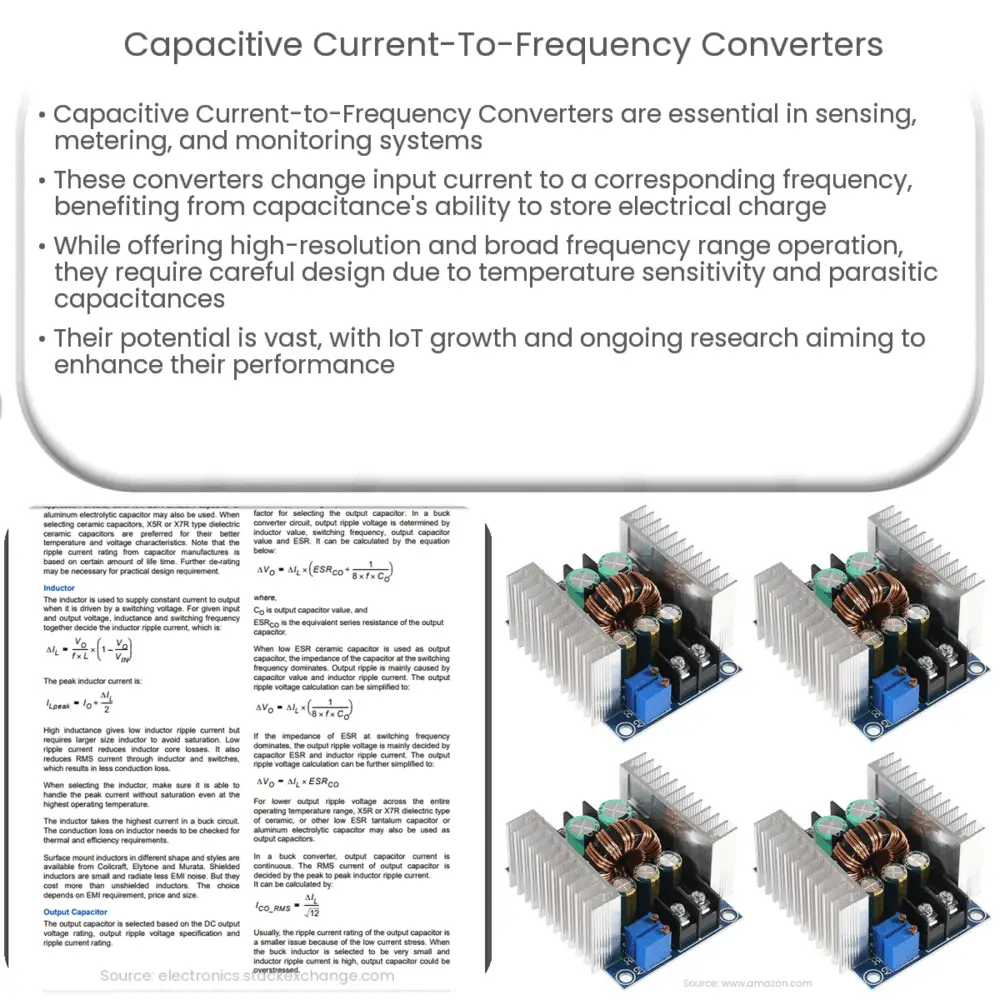Explore the basics, working, applications, and challenges of Capacitive Current-to-Frequency Converters in modern electronics.

Understanding Capacitive Current-to-Frequency Converters
A Capacitive Current-to-Frequency Converter is a critical piece of technology that finds extensive use in different applications, including sensing, metering, and monitoring systems. To understand this device’s operation, we need to delve into the fundamental principles of electronics.
Basic Principles
Capacitance is an electrical property of an electronic component that enables it to store an electrical charge. The unit of capacitance is the farad (F), named after Michael Faraday, an English scientist who significantly contributed to the study of electromagnetism and electrochemistry.
In a basic configuration, a current-to-frequency (I/F) converter changes an input current into a corresponding frequency. This conversion process is fundamental in many electronic systems, as it allows for analog to digital conversion, which is essential for digital systems to interact with the physical world.
The Working of Capacitive Current-to-Frequency Converters
When we combine these two principles – capacitance and I/F conversion – we get a capacitive current-to-frequency converter. In such a system, a capacitor charges up via a constant current source. As the capacitor reaches a predetermined voltage, a comparator recognizes this condition and resets the capacitor, generating a pulse at the same time.
Essentially, the rate (frequency) of the pulse generation directly corresponds to the input current, allowing a seamless conversion from an electrical current to a frequency signal. This forms the backbone of many practical applications, such as sensors and metering systems, where accurate measurements are crucial.
Applications of Capacitive Current-to-Frequency Converters
- Sensing: Capacitive sensors make use of these converters to measure various physical quantities, including pressure, humidity, and displacement. The change in capacitance due to the change in these physical properties is converted into a corresponding frequency.
- Metering: In power metering, the converter can translate electrical current into a frequency signal, providing a readable output to digital systems.
To be noted that the above-mentioned uses only scratch the surface of how capacitive current-to-frequency converters can be employed. Their flexibility in design and application has led to their use in an array of electronics and communication systems.
Key Advantages and Limitations
Capacitive current-to-frequency converters offer several key advantages. They enable high-resolution measurements and can operate over a broad frequency range. Moreover, they are less susceptible to noise, ensuring a reliable signal transmission. However, they may also face challenges like sensitivity to temperature changes and parasitic capacitances which need to be accounted for in their design.
Design Considerations and Challenges
While capacitive current-to-frequency converters offer numerous advantages, designers need to consider certain factors to maximize their performance. One such factor is temperature stability. The properties of capacitors can change with temperature, which can affect the converter’s performance. Therefore, the choice of capacitor and circuit design should account for the operating temperature range.
Parasitic capacitance is another crucial aspect that can affect the performance of the converter. Parasitic capacitance is unintended capacitance that can occur within the circuit due to the proximity of different components. This can cause errors in the frequency output and should be minimized as much as possible through careful circuit layout and design.
Future Prospects
The potential for capacitive current-to-frequency converters is vast. With advancements in electronics and technology, their applications can extend further. The growth in Internet of Things (IoT) applications, for instance, may provide more opportunities for these converters as there will be increased need for compact and efficient data conversion methods.
Innovations and Research
In the realm of research, there is active exploration on improving the performance and robustness of these converters. New materials and designs are being tested for capacitors to reduce their temperature sensitivity and enhance their stability. Moreover, innovative circuit layouts are being investigated to minimize parasitic capacitances and maximize accuracy.
Conclusion
In conclusion, capacitive current-to-frequency converters play a critical role in various applications ranging from sensing systems to power metering. Their ability to convert electrical current into a frequency signal in a precise manner forms the foundation of many electronic and communication systems. Despite facing challenges such as temperature sensitivity and parasitic capacitances, their benefits far outweigh the limitations. With continuous research and advancements in technology, these converters are poised to make a significant impact in the electronics industry, paving the way for more efficient, compact, and precise systems. Therefore, understanding their operation, applications, and challenges is imperative for anyone involved in the field of electronics and communication.

